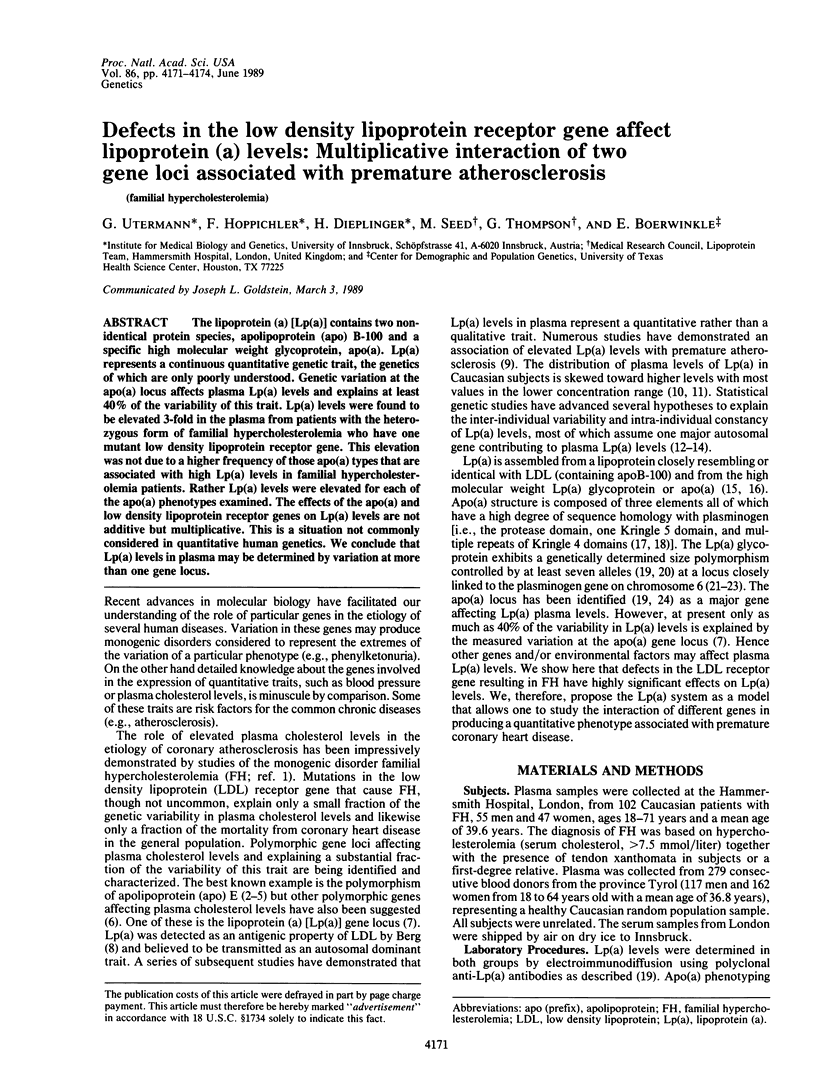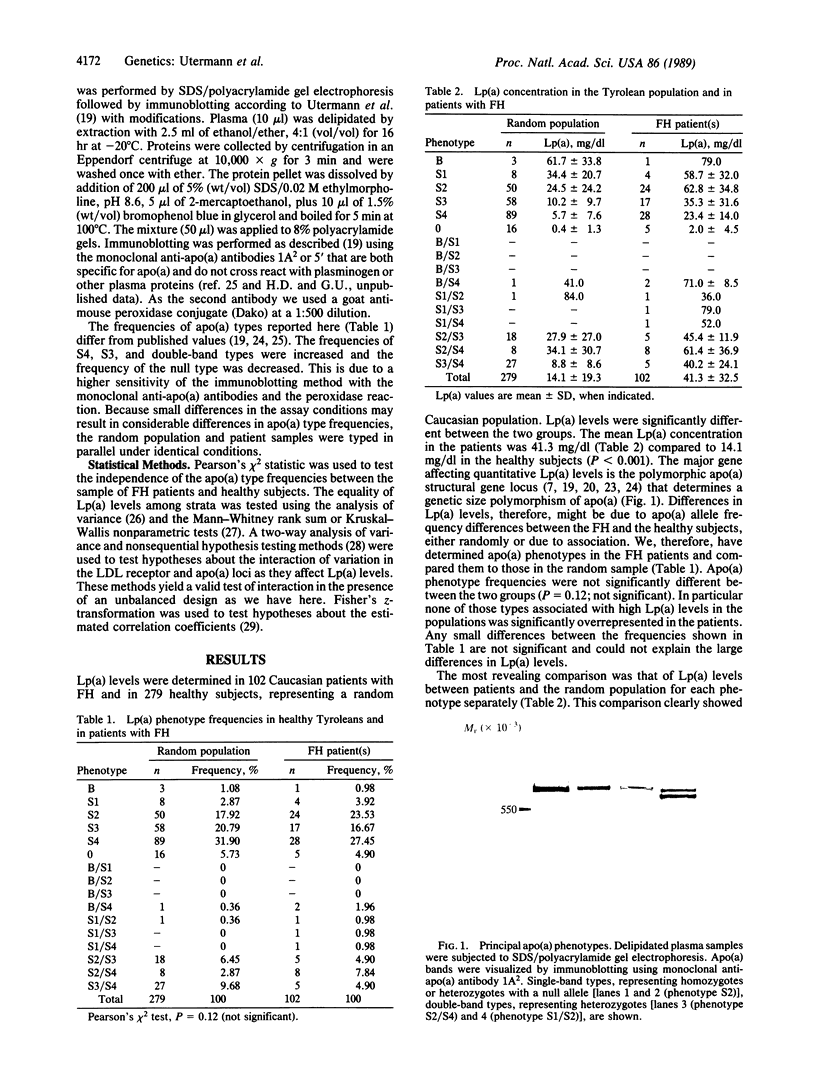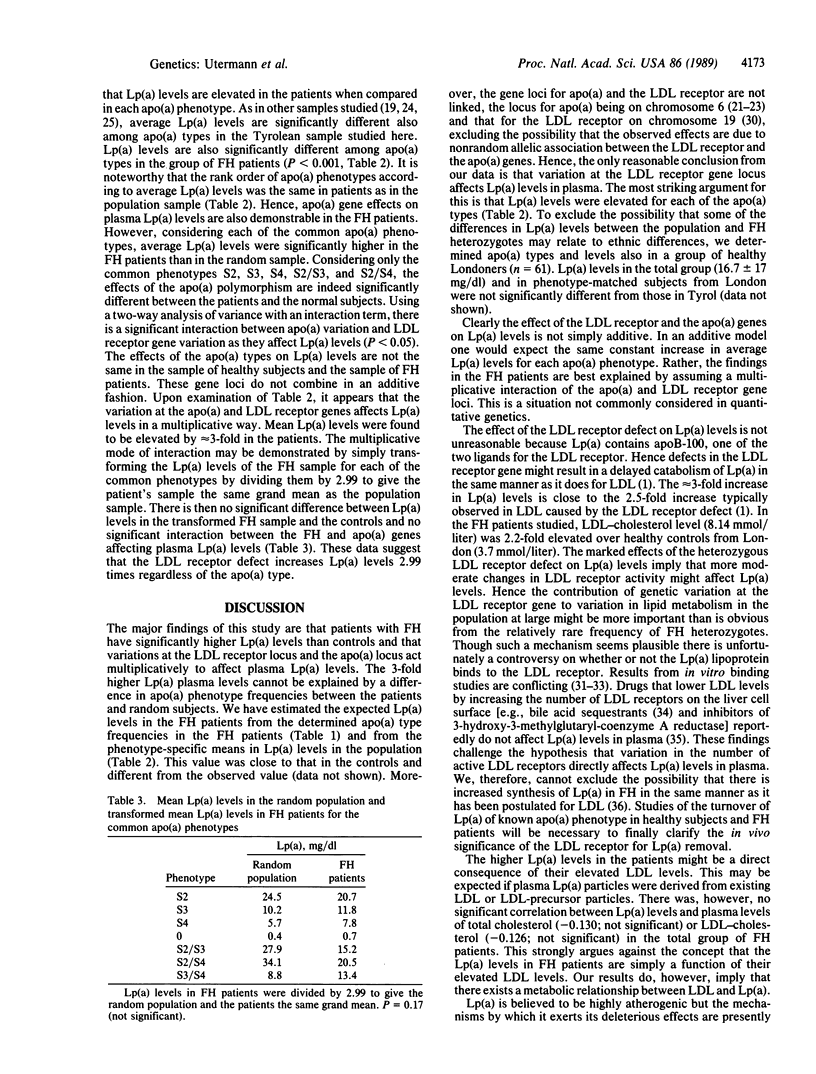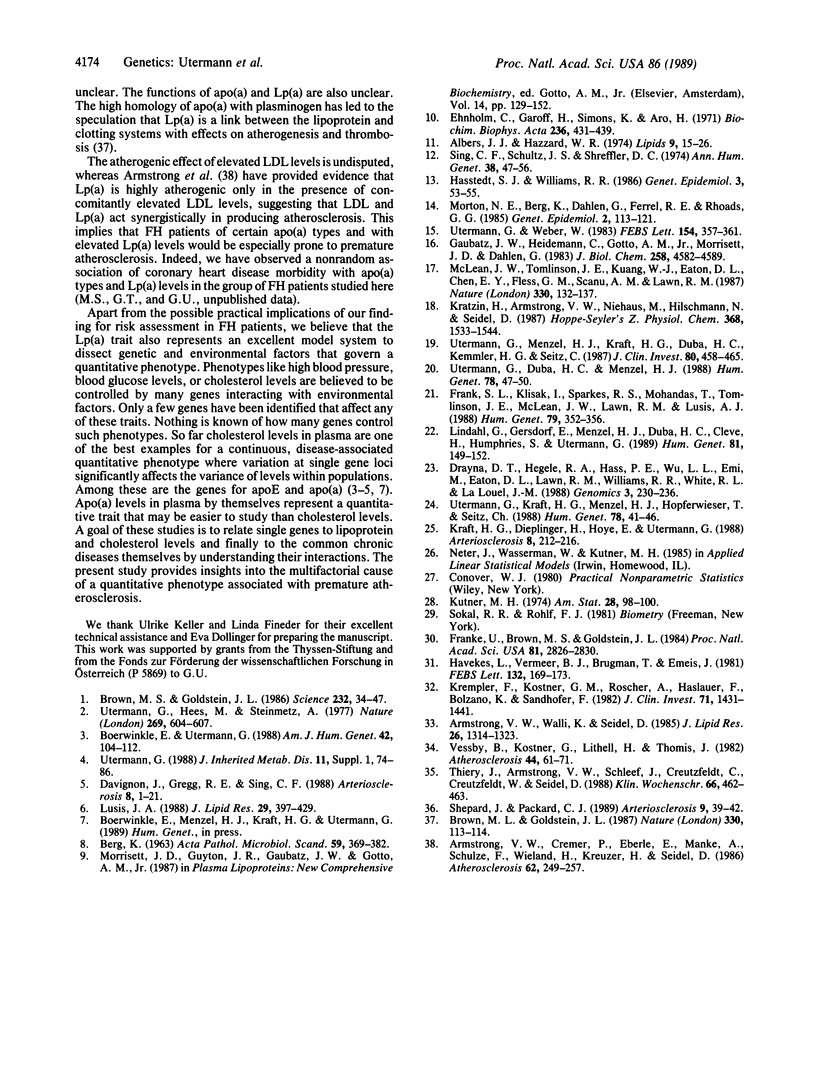Abstract
The lipoprotein (a) [Lp(a)] contains two nonidentical protein species, apolipoprotein (apo) B-100 and a specific high molecular weight glycoprotein, apo(a). Lp(a) represents a continuous quantitative genetic trait, the genetics of which are only poorly understood. Genetic variation at the apo(a) locus affects plasma Lp(a) levels and explains at least 40% of the variability of this trait. Lp(a) levels were found to be elevated 3-fold in the plasma from patients with the heterozygous form of familial hypercholesterolemia who have one mutant low density lipoprotein receptor gene. This elevation was not due to a higher frequency of those apo(a) types that are associated with high Lp(a) levels in familial hypercholesterolemia patients. Rather Lp(a) levels were elevated for each of the apo(a) phenotypes examined. The effects of the apo(a) and low density lipoprotein receptor genes on Lp(a) levels are not additive but multiplicative. This is a situation not commonly considered in quantitative human genetics. We conclude that Lp(a) levels in plasma may be determined by variation at more than one gene locus.
Full text
PDF



Images in this article
Selected References
These references are in PubMed. This may not be the complete list of references from this article.
- Albers J. J., Hazzard W. R. Immunochemical quantification of human plasma Lp(a) lipoprotein. Lipids. 1974 Jan;9(1):15–26. doi: 10.1007/BF02533209. [DOI] [PubMed] [Google Scholar]
- Armstrong V. W., Cremer P., Eberle E., Manke A., Schulze F., Wieland H., Kreuzer H., Seidel D. The association between serum Lp(a) concentrations and angiographically assessed coronary atherosclerosis. Dependence on serum LDL levels. Atherosclerosis. 1986 Dec;62(3):249–257. doi: 10.1016/0021-9150(86)90099-7. [DOI] [PubMed] [Google Scholar]
- Armstrong V. W., Walli A. K., Seidel D. Isolation, characterization, and uptake in human fibroblasts of an apo(a)-free lipoprotein obtained on reduction of lipoprotein(a). J Lipid Res. 1985 Nov;26(11):1314–1323. [PubMed] [Google Scholar]
- BERG K. A NEW SERUM TYPE SYSTEM IN MAN--THE LP SYSTEM. Acta Pathol Microbiol Scand. 1963;59:369–382. doi: 10.1111/j.1699-0463.1963.tb01808.x. [DOI] [PubMed] [Google Scholar]
- Boerwinkle E., Utermann G. Simultaneous effects of the apolipoprotein E polymorphism on apolipoprotein E, apolipoprotein B, and cholesterol metabolism. Am J Hum Genet. 1988 Jan;42(1):104–112. [PMC free article] [PubMed] [Google Scholar]
- Brown M. S., Goldstein J. L. A receptor-mediated pathway for cholesterol homeostasis. Science. 1986 Apr 4;232(4746):34–47. doi: 10.1126/science.3513311. [DOI] [PubMed] [Google Scholar]
- Brown M. S., Goldstein J. L. Plasma lipoproteins: teaching old dogmas new tricks. Nature. 1987 Nov 12;330(6144):113–114. doi: 10.1038/330113a0. [DOI] [PubMed] [Google Scholar]
- Davignon J., Gregg R. E., Sing C. F. Apolipoprotein E polymorphism and atherosclerosis. Arteriosclerosis. 1988 Jan-Feb;8(1):1–21. doi: 10.1161/01.atv.8.1.1. [DOI] [PubMed] [Google Scholar]
- Drayna D. T., Hegele R. A., Hass P. E., Emi M., Wu L. L., Eaton D. L., Lawn R. M., Williams R. R., White R. L., Lalouel J. M. Genetic linkage between lipoprotein(a) phenotype and a DNA polymorphism in the plasminogen gene. Genomics. 1988 Oct;3(3):230–236. doi: 10.1016/0888-7543(88)90084-5. [DOI] [PubMed] [Google Scholar]
- Ehnholm C., Garoff H., Simons K., Aro H. Purification and quantitation of the human plasma lipoprotein carrying the Lp(a) antigen. Biochim Biophys Acta. 1971 May 25;236(2):431–439. doi: 10.1016/0005-2795(71)90223-6. [DOI] [PubMed] [Google Scholar]
- Francke U., Brown M. S., Goldstein J. L. Assignment of the human gene for the low density lipoprotein receptor to chromosome 19: synteny of a receptor, a ligand, and a genetic disease. Proc Natl Acad Sci U S A. 1984 May;81(9):2826–2830. doi: 10.1073/pnas.81.9.2826. [DOI] [PMC free article] [PubMed] [Google Scholar]
- Frank S. L., Klisak I., Sparkes R. S., Mohandas T., Tomlinson J. E., McLean J. W., Lawn R. M., Lusis A. J. The apolipoprotein(a) gene resides on human chromosome 6q26-27, in close proximity to the homologous gene for plasminogen. Hum Genet. 1988 Aug;79(4):352–356. doi: 10.1007/BF00282175. [DOI] [PubMed] [Google Scholar]
- Gaubatz J. W., Heideman C., Gotto A. M., Jr, Morrisett J. D., Dahlen G. H. Human plasma lipoprotein [a]. Structural properties. J Biol Chem. 1983 Apr 10;258(7):4582–4589. [PubMed] [Google Scholar]
- Hasstedt S. J., Williams R. R. Three alleles for quantitative Lp(a). Genet Epidemiol. 1986;3(1):53–55. doi: 10.1002/gepi.1370030106. [DOI] [PubMed] [Google Scholar]
- Havekes L., Vermeer B. J., Brugman T., Emeis J. Binding of LP(a) to the low density lipoprotein receptor of human fibroblasts. FEBS Lett. 1981 Sep 28;132(2):169–173. doi: 10.1016/0014-5793(81)81153-2. [DOI] [PubMed] [Google Scholar]
- Kraft H. G., Dieplinger H., Hoye E., Utermann G. Lp(a) phenotyping by immunoblotting with polyclonal and monoclonal antibodies. Arteriosclerosis. 1988 May-Jun;8(3):212–216. doi: 10.1161/01.atv.8.3.212. [DOI] [PubMed] [Google Scholar]
- Kratzin H., Armstrong V. W., Niehaus M., Hilschmann N., Seidel D. Structural relationship of an apolipoprotein (a) phenotype (570 kDa) to plasminogen: homologous kringle domains are linked by carbohydrate-rich regions. Biol Chem Hoppe Seyler. 1987 Dec;368(12):1533–1544. doi: 10.1515/bchm3.1987.368.2.1533. [DOI] [PubMed] [Google Scholar]
- Krempler F., Kostner G. M., Roscher A., Haslauer F., Bolzano K., Sandhofer F. Studies on the role of specific cell surface receptors in the removal of lipoprotein (a) in man. J Clin Invest. 1983 May;71(5):1431–1441. doi: 10.1172/JCI110896. [DOI] [PMC free article] [PubMed] [Google Scholar]
- Lindahl G., Gersdorf E., Menzel H. J., Duba C., Cleve H., Humphries S., Utermann G. The gene for the Lp(a)-specific glycoprotein is closely linked to the gene for plasminogen on chromosome 6. Hum Genet. 1989 Jan;81(2):149–152. doi: 10.1007/BF00293891. [DOI] [PubMed] [Google Scholar]
- Lusis A. J. Genetic factors affecting blood lipoproteins: the candidate gene approach. J Lipid Res. 1988 Apr;29(4):397–429. [PubMed] [Google Scholar]
- McLean J. W., Tomlinson J. E., Kuang W. J., Eaton D. L., Chen E. Y., Fless G. M., Scanu A. M., Lawn R. M. cDNA sequence of human apolipoprotein(a) is homologous to plasminogen. Nature. 1987 Nov 12;330(6144):132–137. doi: 10.1038/330132a0. [DOI] [PubMed] [Google Scholar]
- Morton N. E., Berg K., Dahlen G., Ferrell R. E., Rhoads G. G. Genetics of the Lp lipoprotein in Japanese-Americans. Genet Epidemiol. 1985;2(2):113–121. doi: 10.1002/gepi.1370020202. [DOI] [PubMed] [Google Scholar]
- Sing C. F., Schultz J. S., Shreffler D. C. The genetics of the Lp antigen. II. A family study and proposed models of genetic control. Ann Hum Genet. 1974 Jul;38(1):47–56. doi: 10.1111/j.1469-1809.1974.tb01992.x. [DOI] [PubMed] [Google Scholar]
- Thiery J., Armstrong V. W., Schleef J., Creutzfeldt C., Creutzfeldt W., Seidel D. Serum lipoprotein Lp(a) concentrations are not influenced by an HMG CoA reductase inhibitor. Klin Wochenschr. 1988 May 16;66(10):462–463. doi: 10.1007/BF01745519. [DOI] [PubMed] [Google Scholar]
- Utermann G., Duba C., Menzel H. J. Genetics of the quantitative Lp(a) lipoprotein trait. II. Inheritance of Lp(a) glycoprotein phenotypes. Hum Genet. 1988 Jan;78(1):47–50. doi: 10.1007/BF00291233. [DOI] [PubMed] [Google Scholar]
- Utermann G., Hees M., Steinmetz A. Polymorphism of apolipoprotein E and occurrence of dysbetalipoproteinaemia in man. Nature. 1977 Oct 13;269(5629):604–607. doi: 10.1038/269604a0. [DOI] [PubMed] [Google Scholar]
- Utermann G., Kraft H. G., Menzel H. J., Hopferwieser T., Seitz C. Genetics of the quantitative Lp(a) lipoprotein trait. I. Relation of LP(a) glycoprotein phenotypes to Lp(a) lipoprotein concentrations in plasma. Hum Genet. 1988 Jan;78(1):41–46. doi: 10.1007/BF00291232. [DOI] [PubMed] [Google Scholar]
- Utermann G., Menzel H. J., Kraft H. G., Duba H. C., Kemmler H. G., Seitz C. Lp(a) glycoprotein phenotypes. Inheritance and relation to Lp(a)-lipoprotein concentrations in plasma. J Clin Invest. 1987 Aug;80(2):458–465. doi: 10.1172/JCI113093. [DOI] [PMC free article] [PubMed] [Google Scholar]
- Utermann G., Weber W. Protein composition of Lp(a) lipoprotein from human plasma. FEBS Lett. 1983 Apr 18;154(2):357–361. doi: 10.1016/0014-5793(83)80182-3. [DOI] [PubMed] [Google Scholar]
- Vessby B., Kostner G., Lithell H., Thomis J. Diverging effects of cholestyramine on apolipoprotein B and lipoprotein Lp(a). A dose-response study of the effects of cholestyramine in hypercholesterolaemia. Atherosclerosis. 1982 Jul;44(1):61–71. doi: 10.1016/0021-9150(82)90053-3. [DOI] [PubMed] [Google Scholar]



